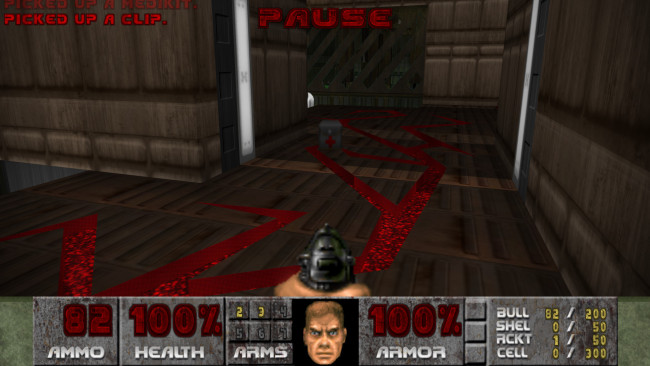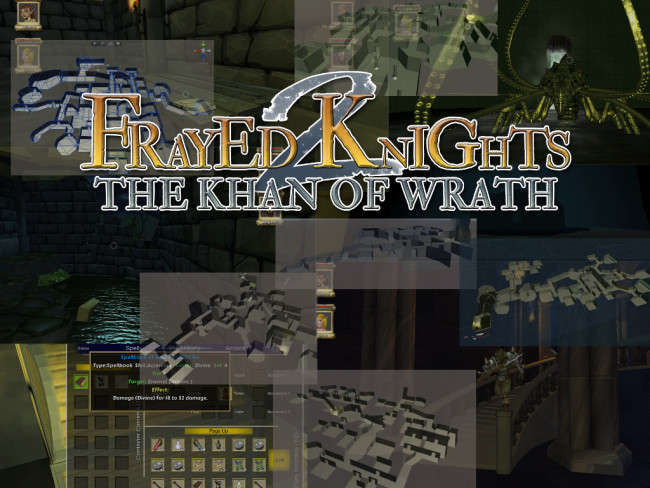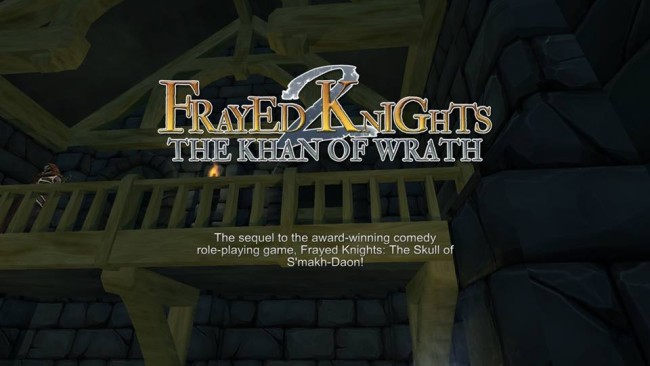Mythica 4: The Iron Crown now crowdfunding
Posted by Rampant Coyote on January 19, 2016
I’ve heaped a bit of praise on the Mythica films. I have a slight bias because I’ve worked with them before when they were involved in a game project, and they are locally produced (Go Utah!). But mostly I think they are just decent low-budget fantasy films… better than a lot of what’s on TV, in fact. The third movie, in particular, impressed me as the best of the series.
Now the fourth has completed filming, and they are once again crowdfunding. I’ve backed it already, although I confess I’m not as impressed with the trailer on this one. The special effects always have the “CGI look” to them, but these seem to stand out more. Hopefully that’s more because of the rush, and they needed a bit more color-correction or something, and won’t be a problem in the final film.
I just know I do want more Mythica. 🙂
They are already more than a third of the way there after just 24 hours. I think that’s a record. If you are interested (and want a signed DVD or BLU-Ray or something), check out the Mythica 4 Kickstarter here.
Here’s the trailer:
Filed Under: Movies - Comments: Read the First Comment
John Romero Releases New Level for Doom
Posted by Rampant Coyote on January 18, 2016
Yeah. This happened.
It's been 21 years since I made a DOOM level. Here's my version of E1M8 using DOOM1.WAD. https://t.co/ueKM7gBbXd pic.twitter.com/NlmA9aIALN
— John Romero (@romero) January 15, 2016
A new Doom level by John Romero himself. It is entitled, “Tech Gone Bad,” and it’s… pretty brutal. Here’s a video of a playthrough (on full difficulty, I believe):
Why? Why now? Is he “getting warmed up” for something else, as he hints in the instructions? What?
Anyway, I played through the level, using the Doomsday Engine with the higher-resolution texture pack. I can’t say I completed it. It is HARD. For one thing, there is environmental damage everywhere. From radioactive slime to cracks of lava appearing everywhere (and even a crack will hurt you) as Hell intrudes in reality. There are lots of switches to open up areas, and more than plenty of monsters, culminating in the fight with the two Barons of Hell as in the original E1M8 which this replaces. Anyway – in a nutshell, it’s a level that seems like it requires a lot of trial and error to learn, and then very skillful play to “win.”
Does this mean anything? I wouldn’t read too much into it. Clearly Romero wanted to exercise his old FPS design skills, and dusted off Doom to get back into that headspace. Maybe this was for a potential upcoming project, or maybe it was just because he was bored and nostalgic. Maybe we’ll learn a reason soon. Maybe there was no reason. Either way, we’ve got a new and at least interesting level designed by one of the original creators of the game, and a founder of the genre.
Yay for us!
And if you are interested in the Doomsday Engine to easily add mods and play the game with modern conveniences – you can grab that here.
Filed Under: Geek Life, Retro - Comments: Read the First Comment
Quick Take: A Lady of Spirit (and the Magnificent Devices series)
Posted by Rampant Coyote on January 15, 2016
Before my first steampunk short story was published (in Terra Mechanica: A Steampunk Anthology – plug! plug!), I was trying to get an idea of the modern “lay of the land” in the steampunk literary field, and I came across the Magnificent Devices series by Shelly Adina. At the time, there were only four books in the series. I read the first one (which was available free on Kindle at the time) in a weekend, looking for a “Steampunk Adventure” series, and within the first couple of chapters I’d decided that I’d stumbled on Young Adult steampunk fiction geared more towards female readers. But I kept reading. And couldn’t stop. Before the weekend was complete, I’d purchased the collection of the first four books of the Magnificent Devices series.
Manliness be damned, these books were fun! They chronicled the adventures of Claire Trevelyan, a debutante with dreams of becoming an engineer, who finds herself impoverished, semi-homeless, and in charge of a street gang of young urchins. She ends up in deadly conflicts fighting off rival street gangs, air pirates, and an overbearing and ruthless fiance. All with fantastic Victorian manners and language. Great stuff!
It took me a while to continuing the series (and I understand book 10 is due out in a few weeks), because the next two were not about Claire. And dang it, I wanted more Claire! But two more novels in, I can say they have proven just as enjoyable. These are all very short novels, which means they are quick reads that don’t overstay their welcome, but they also feel like they are roaring to an exciting conclusion while I’m still getting my bearings as a reader and wanting a little bit more “meat” to the story.
 The sixth book is A Lady of Spirit, and it follows the adventures of Maggie, one of the “mopsies” from the first four books, now older and getting to know her (supposed) family along with her cousin. The first half of the book could almost be simple historical fiction, with just a few weird steampunk elements sitting in the background (like arriving in an airship). Maggie struggles to come to terms with her newly-discovered family, the Seacombes. Her grandparents were clearly unhappy with the scandalous details of her birth and have no desire to welcome her to the family. She soldiers on emotionally for the sake of her cousin, all the while feeling heartbroken and so forth.
The sixth book is A Lady of Spirit, and it follows the adventures of Maggie, one of the “mopsies” from the first four books, now older and getting to know her (supposed) family along with her cousin. The first half of the book could almost be simple historical fiction, with just a few weird steampunk elements sitting in the background (like arriving in an airship). Maggie struggles to come to terms with her newly-discovered family, the Seacombes. Her grandparents were clearly unhappy with the scandalous details of her birth and have no desire to welcome her to the family. She soldiers on emotionally for the sake of her cousin, all the while feeling heartbroken and so forth.
And THEN there’s the smuggling ring, the submarines, and the attempted invasion of England and Prussia with giant steam-powered battle mecha/tank/gun fortresses, big underwater explosions and stuff. HECK YEAH!!!!!
So… um, yeah. Fun book in a fun series. While not my favorite of the series, I enjoyed it a great deal.
Filed Under: Books - Comments: Read the First Comment
Frayed Knights 2: January WIP Stuff
Posted by Rampant Coyote on January 14, 2016
How about an eye-searing jumble of work-in-progress images from Frayed Knights 2? Sure! I should have had an artist work on this, but it was late and I thought I’d show once again why I should stick with design and programming. Anyway, I was really trying to show some of the maps without actually, you know, showing the maps. But honestly the screenshots are generally cooler, even if some are kind of embarrassingly blemished with work-in-progress unfinished-ness.
While I don’t really have a milestone to announce, in a way, this image dump represents the end of a lot of the early-phase, ‘pre-alpha’ stuff. Which is kinda funny, since I thought the demo we showed during the late-summer and fall was pretty polished and a good representation of the game. But it was still just a “vertical slice.” Since then we’ve been transitioning into making it a full (and probably too large) role-playing game.
Over the last several weeks, I’ve focused on getting all of the levels in Frayed Knights 2: The Khan of Wrath complete enough to pass them off to the art guys. That means designed, whiteboxed, and navigable. The latter is a little tricky because I really like to make my levels impossible to just walk through from beginning to end, even before they are filled with locks, traps, and monsters. I like to have parts of the dungeon move, and these cool vertical areas that there’s a trick to navigating. That’s required some scripting. Anyway, I had a goal to get that done by the end of the year, and I fell a little short, although progress has accelerated and I can see the light at the end of the tunnel.
There are more, and significantly bigger, dungeons in Frayed Knights 2. In part, this is because I’m compensating for eliminating the outdoor areas. In the first game, those were fun to explore once, but then took a long time to walk through and became a little tedious. They also consumed a lot of art resources for places that weren’t really a focal point of the game. So instead, the dungeon crawling is bigger and (I believe and hope) better.
Unfortunately, that hasn’t led to a lot for me to talk about here on the blog. I don’t mind dropping a few teasers here and there, but I don’t want to go into too much detail. That’s the stuff that you’ll want to explore. It gets a little exhausting coming up with all the puzzles, tricks, stories, and and unusual situations in each dungeon. Just like the first game, I avoid having levels just be a sequence of fights (or fights and traps). For me, exploration means finding new, interesting stuff. So while every room might not be a cornucopia of fascinating delight and wonder, I don’t want to just drop a few orcs behind every door.
I also approach the design of each level more like I would a dice & paper RPG. That’s not to say I don’t borrow “bits” from classic CRPGs. Those are in there too. But I find that thinking about the design in terms of a human-moderated game and then try to see how I’d translate it into the computer. Sometimes it doesn’t work, but other times it does. Worst-case, when I really love something but it doesn’t translate well, I keep it and use text and dialog to explain what’s going on. As always, if you hate reading text, this game might not be for you.
We’ve still got a lot to do, but the pace is accelerating, and as I hope this dumb little image represents, we’ve come a long way. Over the next few weeks, I expect the screenshots will start appearing more regularly as I have stuff actually worthy of showing off.
This is where things start really getting fun. And crazy.
Filed Under: Frayed Knights - Comments: 4 Comments to Read
Indie In Arcade Cabinets
Posted by Rampant Coyote on January 13, 2016
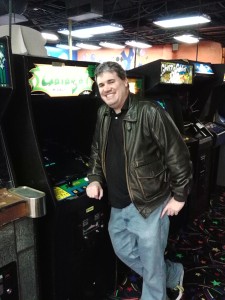 The arcade is dead. Well, mostly. There are a couple of them still around in my area, which I need to go to more frequently, because it’s FUN and I want to support them. But these delightful places that in some ways defined my youth are no longer a thing. A going concern. Like phone booths and cassette tapes, these once-constant elements of daily western life have all but disappeared, now serving only in a minimal capacity.
The arcade is dead. Well, mostly. There are a couple of them still around in my area, which I need to go to more frequently, because it’s FUN and I want to support them. But these delightful places that in some ways defined my youth are no longer a thing. A going concern. Like phone booths and cassette tapes, these once-constant elements of daily western life have all but disappeared, now serving only in a minimal capacity.
But for many game developers who remember that era (and even some who don’t), seeing our games in an arcade cabinet remains a weird aspiration. It’s not even purely a nostalgia thing. It’s the concept of having your game out there in a public venue, where anyone can walk up and play it, anonymously. We get a little bit of that if we have our games up at shows or conventions, but it’s not the same.
Some indies are doing that, and learning a bit from the experience, as found in an article in Gamasutra: Lessons Learned from Porting Indie Games Onto Arcade Cabinets. It’s not just a straightforward thing. An excerpt:
“The arcade is a very different place from the privacy and solitude of most people’s gaming dens. It’s a place of noise and flashing lights, where games compete to attract your attention. Simplicity and approachability is key, here: players need to feel they can jump right in and start playing the game. They need to know at a glance what your game is, and how to play it. A completely unique controller or visual style can also help to set you apart.”
As much as I would like to, I still can’t fathom a practical, profitable reason to make indie games for arcade cabinets. There are really just two reasons. The first is simply “because it’s cool!” Which, as a low-budget, low-overhead indie, might be enough. Based on my limited experience showing my game at public conventions, I think the experience – and actually getting it into an arcade-like venue, open to the public and being able to silently watch how people react – would be like a master’s class in game design.
Something else I’m gonna have to do someday…
Filed Under: Indie Evangelism, Retro - Comments: Read the First Comment
Quick Take: Hellhound On My Trail
Posted by Rampant Coyote on January 12, 2016
 A rock band that changes its name for every gig. A new bassist with an unpleasant past haunted (literally) by the ghost of his brother, contemplating suicide. Some twists on religious tradition and mythology. A giant attacking hellhound and swarms of demonic giant flies. And lots of guns, knives, swords, and chase scenes.
A rock band that changes its name for every gig. A new bassist with an unpleasant past haunted (literally) by the ghost of his brother, contemplating suicide. Some twists on religious tradition and mythology. A giant attacking hellhound and swarms of demonic giant flies. And lots of guns, knives, swords, and chase scenes.
That pretty much sums up Hellhound On My Trail, by D. J. Butler. It’s the first book of the Rock Band Fights Evil series, and if the first book is any indication, the series is exactly what it says on the tin. It’s a short novel and a quick read that stomps the accelerator in chapter 1 and never really lets off much.
The titular “Rock Band” consists of a bunch of musicans who aren’t exactly on God’s good side. But they haven’t thrown in with the opposition either; on the contrary, they have a bone to pick with the forces of evil, for individual reasons.
Mike Archuleta is a replacement bassist planning on getting drunk and committing suicide after this last gig, but his plans are interrupted by a fiery monster from hell attacking the band. While his checkered past means he’s no slouch with a handgun, he’s the newbie on the team, and spends a lot of the time asking the other band members what’s going on. That’s perhaps the biggest downside to the book, and one I hope to see less of in future installments. At least the mythology Butler builds here is pretty interesting stuff.
While there’s a smattering of horror and comedy (I particularly love Eddie Marlow’s hilarious back-story of a crossroads deal gone wrong), for the most part the book is straight-up pulp-style action and adventure. Which I’m totally down with. I look forward to reading the rest of the series.
Filed Under: Books - Comments: Comments are off for this article
Farewell David Bowie
Posted by Rampant Coyote on January 11, 2016
David Bowie was an old-school veteran rocker by the time I was old enough to pay attention. But where others of his generation of rock legends had died, burned out, or faded away, he kept reinventing himself and staying current – and producing hit songs.
But as much as I enjoyed many of his songs, the winner for me was his performance as the villain / foil in Labyrinth, Jareth the Goblin King. I thought he did a great job in Into the Night and as Nikola Tesla in The Prestige as well. But Jareth was, and is, just plain awesome. Seriously, if you’ve never seen the movie, embrace your inner child and enjoy it.
Ch… ch… ch… ch… changes.
RIP, dude. You rocked, literally.
Filed Under: General - Comments: 3 Comments to Read
And the next uber-cheap computer is…
Posted by Rampant Coyote on January 8, 2016
 Okay, the Raspberry Pi Zero at $5 is pretty dang amazing. Phenomenal, really. Its more powerful siblings are also pretty impressive. They made waves.
Okay, the Raspberry Pi Zero at $5 is pretty dang amazing. Phenomenal, really. Its more powerful siblings are also pretty impressive. They made waves.
So of course… it’s competition time! Well, more competition.
Next out of the gate is the PINE 64, now in a crowdfunding & manufacturing phase. While the release of the Pi Zero at the $5 price point may have stolen some of its thunder, it is really aiming at being more powerful system than the Raspberry Pi… and yet it still comes in at a lower price than the the other Raspberry Pi models. It’s a 64-bit quad-core 1.2 ghz machine with a dual-core graphics processor and 4K HDMI output. Once upon a time, this would have sounded like a dream game console (its graphics capabilities are supposed to be – theoretically – slightly higher than the level of the original XBox). It runs Linux and Android.
They even captured a little bit of the low-price high ground (that’s kind of a mixed metaphor, isn’t it?) by offering a very limited run of $5 models without an Ethernet port, which are very, very sold out and probably won’t be coming back.
Okay, it sounds really cool to me… a powerful competitor for the Pi, at a ridiculous price. A great hobby system. But… there are more questions. What kind of support will it get? Even if it beats out the Raspberry Pi on specs, will it really be able to compete? Are there really a lot of projects for the uber-low-end computer where people were limited by a lack of horsepower?
At $15 ($19 for the A64+), it’s not exactly a high-risk gamble for the buyer, and should be a contender even if its extra horsepower isn’t necessary. With Android or Linux and standard interfaces, it should be pretty compatible with plenty of hardware and software. But it’s not a consumer-level system (so much for my dreams of treating this like a gaming platform!). It’s a Do-It-Yourself (DIY)
Ultimately, it comes down to a question for me: what would I personally *DO* with it? It’s got all kinds of cool factor, but it’s still kind of a solution in search of a problem. But for hobbyists who want cheap and expendable “brains” for a project, this should be more than capable enough.
Anyway – it’s interesting, blew well past its funding goal, and I thought people might be interested. And I may end up grabbing one and … doing something with it. Probably involving games.
If you are interested, you can check it out here:
Filed Under: Geek Life - Comments: Comments are off for this article
Escapes and Subjectivity
Posted by Rampant Coyote on January 7, 2016
When I was younger (and sleeping a lot more than I probably needed to), I suffered from insomnia. A lot. Nowadays, I usually only have that problem when my sleep schedule has been seriously messed up … with travel, more often than not… or when I’m sick.
When I finally give up on trying to sleep for a while, I seek out some kind of entertainment. I don’t know what it is, but when I seek escape from sleeplessness at 4AM, whatever it is that provides that refuge wins extra points in my esteem. I mean, serious points. Maybe it’s because my brain is in some limbo between wakefulness and sleep – not fully awake but refusing to settle down. More likely, it’s because I’m just so grateful for something to provide me with an escape from the frustration of being unable to sleep.
Even years later, I remember that book, game, or movie with a special fondness that has nothing to do with the quality of the title itself, and everything to do with it satisfying a mild desperation. But it is impossible for me to completely disassociate myself with that subjective reaction.
When you need an escape, suddenly an ‘escapist’ work becomes the best thing in the world.
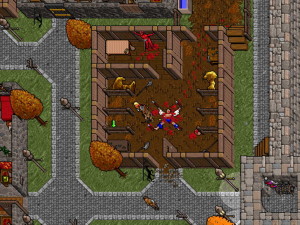 I sometimes wonder if my love of Ultima VII: The Black Gate, and its status as my favorite RPG of all time, isn’t at least partly because I was in a lot of pain when I completed the last 8 hours of the game. During that time, the game made me forget the pain. It was relief.
I sometimes wonder if my love of Ultima VII: The Black Gate, and its status as my favorite RPG of all time, isn’t at least partly because I was in a lot of pain when I completed the last 8 hours of the game. During that time, the game made me forget the pain. It was relief.
Which is kind of weird – in many cases, you think that an experience like this would remind you of your emotional state you were in when you experienced it. And that’s true too. I know there are some movies that I think of very fondly and probably hold a higher opinion of because of the company I was with. So I guess it goes both ways.
In reviews, there’s a call for objectivity, as the reviewer is supposed to be making a buying recommendation. But maybe what we need more of is these subjective discussions.
I mean, I can discuss all the features of Ultima VII and why it’s a great game all day long. I’m down with that. But maybe it’s more important that for 8 hours with a injured knee – bad enough that still gave me periodic problems for TWO YEARS after that – I was able to forget about my pain and lose myself in Britannia? I think that’s a hearty recommendation right there.
Filed Under: Geek Life - Comments: 3 Comments to Read
Virtual Reality Has a Date
Posted by Rampant Coyote on January 6, 2016
 The Oculus Rift is now available for pre-order, and will be shipping starting in March (although right now it says expect shipment in May). You can pre-order at the Oculus Rift website.
The Oculus Rift is now available for pre-order, and will be shipping starting in March (although right now it says expect shipment in May). You can pre-order at the Oculus Rift website.
Of course, Gear VR has been out for a few weeks, and anyone who wanted a developer kit has it.
At $599 – with an XBox controller instead of their custom controller – it’s a little pricier than I anticipated. I was guessing a sub-$500 price tag.
The HTC Vive headset is supposed to arrive in April. They delayed it for what they termed a “breakthrough.” This turned out to be a camera built into the headset that allows the wearer to “see” the room if necessary and avoid colliding with objects, as the Vive is intended to be used in more of an open space. Pricing (to my knowledge) hasn’t been set yet, but rumor has it they are going for more of a “premium” higher-end experience. I don’t really have an entire room to devote to VR, so I’m not quite onboard with this one yet.
Of course, having a PC beefy enough to handle VR is another story. My PC is fairly recent (not quite 18 months) and no gaming slouch, but I may have to upgrade the graphics card… which will be another expense on top of this.
It’ll be exciting to see if this technology really takes off or if it’ll just stay in a niche.
Filed Under: Virtual Reality - Comments: Read the First Comment
Mythica 3: The Necromancer
Posted by Rampant Coyote on January 5, 2016
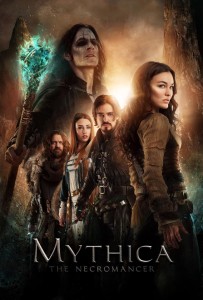 I grew up watching B fantasy films, because I was a D&D geek and that was all that was available in the 1980s, with a few exceptions like Conan the Barbarian, Ladyhawke, and Excaliber. Most of the fantasy films of that era were pretty horrible. And yes, apparently I’m the only RPG geek who didn’t develop an appreciation for Hawk the Slayer. My wife tells me I am completely wrong in this regard.
I grew up watching B fantasy films, because I was a D&D geek and that was all that was available in the 1980s, with a few exceptions like Conan the Barbarian, Ladyhawke, and Excaliber. Most of the fantasy films of that era were pretty horrible. And yes, apparently I’m the only RPG geek who didn’t develop an appreciation for Hawk the Slayer. My wife tells me I am completely wrong in this regard.
I enjoyed the first two Mythica films – A Quest for Heroes and The Darkspore – the first a bit more than the second. Mythica: A Quest for Heroes was the film I’d wanted to see as a 14-year old desperate for a movie to capture the D&D flavor and experience. It’s a low-budget fantasy movie that seems right out of somebody’s fantasy RPG campaign. Of course, we’re living in a post-Lord of the Rings world, so the clearly budget sets and special effects don’t hold up against much scrutiny. At best, they don’t draw attention to themselves, and are equal to what you’d see on television these days. At worst, they are at least an improvement over the special effects of those B-movies of the 80s. Hawk the Slayer included. (Hopefully I won’t have to sleep on the couch for that one).
A Quest for Heroes was pretty safe, almost cute. There was a dark side… freaky necromancy powers, slavery, a casual decapitation, etc. But mostly it was an origin story for what was almost a vanilla set of young adventurers: A wizard with a club foot and a dark power she doesn’t understand; a happy-go-lucky thief with commitment issues; a hard-drinking veteran warrior with a sense of honor, and a priestess of the goddess of light who keeps her party from dying from their injuries. They face CGI monsters and people dressed in the standard Arrowstorm orc costumes, win the day, make 2nd level (I imagine), and party in the tavern. If you consider yourself a role-playing gamer, I recommend the movie, warts and all. Again, it’s low-budget fare, so set expectations appropriately, but it’s fun and entertaining.
In the second film, The Darkspore, things get darker. Marek’s necromancy powers start exceeding her control, there’s party dissension. A shirtless elf joins the party, and they have to fight a scary undead dragon. Marek’s past – and her escaped slave status – comes back to haunt her.
So now we come to the third in the series – Mythica: The Necromancer. I’m just gonna say right now that a group of us saw it together, and unanimously felt that this was the best of the three films. I don’t know if it stands well on its own; much depends on the setup and character development from the previous two movies. But it actually manages to elevate the other two, tying things together.
I am pretty sure the subtitle The Necromancer applies to the villain Szorlok (Matthew Mercer), although it is equally applicable to the principle protagonist Marek (Melanie Stone). After the epic quests of the last movies, this one feels far more down-to-earth, at least at the start, and yet hits more dramatic heights and really brings more out of each of the characters.
The quest this time is a lot more gritty. The head of the thieves’ guild, Peregus (Robert Jayne), captures Thane (Adam Johnson) in order to exact revenge for events in the previous movie. He offers the adventurers a deal – recover some smuggled goods for him across the border, and he’ll release Thane. Of course, the boarder is in the middle of an armed conflict involving enemy soldiers and orcs, the smuggled goods are a drug, and they’ll have Peregus’s creepy, ruthless henchman Betylla with them instead of Thane.
And… and… and… There’s a lot more to it than this. Including some subtleties which are really nice. The characters are given a chance to evolve in this story. Even a thug like Betylla is given a couple of lines and actions to give him an extra dimension, and a spark of humanity.
But most of all, this time, things aren’t safe. It’s not the happy little origin adventure of the first movie, or even the dangerous escalation of the second. In this one, the quest is more intimate, and the stakes – while just as high – are more personal. Some terrible choices have to be made.
I sat down to watch this movie with the expectation of pretty much more of the same. The film plays on that expectation at the beginning, with the group singing drinking songs in the tavern and starting to revel in their evolving role as heroes and adventurers of growing repute and skill. But of course, the simple “milk run” adventure (of course) had far greater consequences than expected, and by the end, everything has changed.
That’s a great place to be for the next two movies. My inner 14-year-old D&D geek is pleased.
I received a Kickstarter backer DVD, but the digital version of the film is available for pre-order now from Arrowstorm.
Filed Under: Movies - Comments: 2 Comments to Read
The Jedi are Mother, the Jedi are Father…
Posted by Rampant Coyote on January 4, 2016
We’re still in a spoiler-free zone here, as this has nothing to do with Star Wars: The Force Awakens, other than having helped inspire this musing. It was also inspired by our Thanksgiving family session of the D20 Star Wars RPG.
I haven’t read many of the non-canonical “Expanded Universe” Star Wars books. So a lot of what I might say may have already been covered by some very talented authors during the dearth of (good) Star Wars movies. And as far as the backstory of the Star Wars universe… hey, Knights of the Old Republic is about as far back as I go.
But mixing some thoughts from the TV series Babylon 5 (still an outstanding sci-fi series that far too many people missed), and the likewise excellent Netflix-produced series Jessica Jones, I’ve devoted far too many brain cells to thinking about the whole Jedi Knight thing.
Although the prequel Star Wars movies handled things very clumsily, they did (accidentally?) introduce a question: If someone really did have supernatural powers that included mind control and mind-reading, how could you actually defend AGAINST someone like that accruing enormous power? Particularly if they managed to work in secrecy? Jessica Jones did a fantastic job of exploring this, with a villain (played perfectly by Doctor Who alumnus David Tennant) whose only real limitation was the pettiness of his ambitions.
I’ve spoken of this before with respect to fantasy economies and magic items. But I’ve begun to wonder if the Jedi Order isn’t a lot like Babylon 5‘s psi corps – a way to impose control over beings with great, often undetectable power. I mean, they begin training (indoctrination?) at an extremely young age, taking the kids from their parents for complete training. “The Corps is Mother, the Corps if Father” anyone? They forbid love and marriage? Why, to prevent the continuation of a force-using bloodline? You know, the Jedi sound kind of scary.
Of course, the most sinister and cultlike aspects really came from the prequel movies. Originally, the Jedi Knights were… Ben Kenobi and Yoda. Yoda was a wise Kung Fu master, and Obi-wan was… well, mostly a cheerleading ghost. Luke clearly grew up a lot after handing his butt handed to him by Vader in The Empire Strikes Back, but that was only partly from Yoda’s training.
Whether Lucas intended it that way or not in the prequels doesn’t really matter anymore. Maybe it’s covered in some of the expanded universe novels and I just missed it. But it’s interesting fodder for game design or fiction. There’s the old saying that power corrupts, and absolute power corrupts absolutely. I’m not sure that’s the case. I think it’s more of a case that power attracts corruption… or that whenever a power rises, someone will move in to seize control of that power, or to limit / destroy it.
Which sucks in real life, but makes for pretty interesting stories.
Filed Under: Design, Geek Life, Movies, Writing - Comments: 5 Comments to Read
Happy New Year!
Posted by Rampant Coyote on December 31, 2015
It’s New Year’s Eve here, and I will be taking tomorrow off of blogging. I’d say that I’ll be sleeping off my revelry from the night before, but ya’ll know me. We’re having friends over, and we may be having some wild, wild … board gaming and competitive Tetris playing until only about an hour before my usual bed time. 😉
2015 was a pretty decent year for me overall. The demo version of Frayed Knights 2: The Khan of Wrath had a pretty successful showing at some conventions. At least as successful as slower-paced, deep RPG can have at a show where people have tiny attention spans as they pass by the booths. Two of my short stories saw publication in anthologies, and I just received notification that another is a finalist in another contest. Just as important, I feel my writing chops have grown significantly over the last two years. Hopefully, if you haven’t read my stories yet, you’ll be able to see the difference in the next game.
Which brings us to 2016. There’s really only one big goal that you’d be interested in: Frayed Knights 2: The Khan of Wrath needs to be completed and shipped. At this point, the job is about 80% content, and there’s a lot left to do. The light at the end of the tunnel feels like only a pinprick of a glow, but at least now it’s visible. But assuming the day job doesn’t get TOO psycho, and the art guys have some time to devote to the game, there’s no reason it can’t happen.
On the writing front, I suspect the bulk of my writing will be for FK2 for at least the first half of the year. The last game was somewhere on the order of 30k words of text, and the new one looks like it will be at least as much.
As a reminder, there’s still a weekend left on the big Steam Sale for the first game:
Frayed Knights: The Skull of S’makh-Daon on Steam – Holiday Sale!
Filed Under: Frayed Knights, Rampant Games - Comments: 2 Comments to Read
RPG Design: Drawing Inspiration from Maps
Posted by Rampant Coyote on December 30, 2015
Level 7. It was the most notorious level of the Ultima Underworld series. It was responsible for me giving up on the game for several weeks. Of course, the reason for all that wasn’t the map itself, but the anti-magic effect. But to me, this is an example of what a really awesome dungeon level looks like (borrowed from the Ultima Codex wiki, although the map itself is generated by the game):
Some might say that since maps like this haven’t been repeated in 20 years, this might be an example of what not to do. Maybe they learned that players don’t like it? Smaller dungeon levels are more successful? Or something? I don’t know. I don’t know that anybody does.
I’ve been looking back at some classic RPG maps (both computer games and dice & paper games) for inspiration as I’m knee-deep building dungeons for Frayed Knights 2 right now. And the operative word really is “inspiration.” I look at them and try to analyze what makes me think of them so fondly. In some cases – like this one – the map is more of the inspiration rather than the memories of what was in it. My memories of this place aren’t all that fresh. In recent re-plays of Ultima Underworld I haven’t gotten this far.
But I loved the game. I even loved this level, although the anti-magic aspect was much more of an annoyance than a fun element. But even if I don’t remember many of the details, this map just screams to me of potential. I love the mix of water and lava in the level – bridges spanning the gaps, even the jumping-stones in the center lava pool. The maze section on the right… maybe not quite so much. Mazes are one of those things that look good on paper (and probably play best on paper), but tend to be more annoying than fun.
I’ve talked about old-school level design before, but mostly in the context of linearity. Bu what I’m thinking about today is more of how a level can capture the imagination. Maybe this is just something that impacts me, because so much of my old-school dice-and-paper experience came from imagination. I’d look at the 2D maps and see 3D movies in my head. There’s no way I can capture that exactly in a video game, even with a huge budget, but I will try. Maps inspire me. I have a map from Zork and a map from Ultima V hanging over my head in my home office where I do most of my game development. These maps represent much more than just their individual games for me.
Whether around a table or in front of a computer or console, these are the feelings I want to get from dungeon crawling:
Exploration: Why big, non-linear maps do it for me. I’m sure there could be a lot to explore in a single room, but the big, sprawling maps with lots of secrets and side-paths are what inspire me.
Problem-Solving: I want challenges to my intellect and problem-solving skills, not just combat. Environmental obstacles and threats.
Secrets: In some ways, this is rewards for exploration. These don’t have to be straight-up treasure – in fact, they should normally not be. Story awards, easter eggs, little jokes, or interesting tidbits can be just as rewarding.
Mysteries: Amusingly, this is both similar to and the opposite of secrets. I want mysteries to unfold as I play – maybe not always to a full conclusion (sometimes unanswered questions are the best stimulation for the imagination). The most basic mystery may be, “Who built this place, and why?” That’s a good starting point, at least. But it’s better to have more mysteries raised as you play through… it helps the level come alive, with blanks getting filled by the imagination.
Monsters: Well, yeah. Duh. I want scary monsters to fight. It gets the blood pumping! But more than that, it’s the THREAT of a monster around every corner and behind every door that is exciting. If there’s actually a monster around every corner and behind every door, it gets tedious. (Something I need to consciously work on as a game developer, and I think many game developers get wrong).
Maybe I’m just weird this way. While I harbor no illusions that my own meager efforts on the mapping & level design front can be as inspirational to anyone else, I hope that I can at least capture enough of a fraction of this feeling and turn it into something entertaining.
Filed Under: Design - Comments: 4 Comments to Read
Why Would Anyone Buy Another RPG?
Posted by Rampant Coyote on December 29, 2015
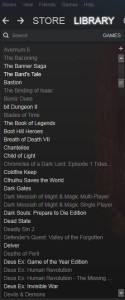 With the bundles and two steam sales recently (Hey, did I mention Frayed Knights is on sale at Steam? Well, consider it mentioned again!), my game collection is threatening to get out of control again. I’m not sure when I’m going to play them all. I do try, at least. Last night I spent some time trying to organize the collection, putting a few finished titles in the “Done” category and trying to figure out into which other categories to file the unplayed ones. Thank you GOG.COM for automatically – kinda – doing that, allowing us to filter results on some level.
With the bundles and two steam sales recently (Hey, did I mention Frayed Knights is on sale at Steam? Well, consider it mentioned again!), my game collection is threatening to get out of control again. I’m not sure when I’m going to play them all. I do try, at least. Last night I spent some time trying to organize the collection, putting a few finished titles in the “Done” category and trying to figure out into which other categories to file the unplayed ones. Thank you GOG.COM for automatically – kinda – doing that, allowing us to filter results on some level.
And then I did a stupid thing. I counted the number of games labeled as RPGs in my Steam collection. Then the number of ones in my GOG.COM collection, of which more than a dozen are duplicates of games I have on Steam. And then I was reminded of why the video game industry *LOVES* the release of a brand-new console. Starting fresh with a blank slate and little competition is huge.
My immediate thought – only mostly joking with myself – was, “Okay, I don’t need to buy another RPG for the rest of my life.” The CRPG Addict has a pretty reasonable six-hour minimum for giving a game a fair shake, and he’s only a little over 200 games in over the course of six years, and he has turned the whole thing into a spare-time devouring quest.
As an RPG developer, that comes with a second thought: Why would anyone buy another RPG? Especially mine. This is a really, really important question. A developer cannot ignore how glutted the market is. This isn’t something I regret. I was a cheerleader and evangelist for this happening. But it comes with problems.
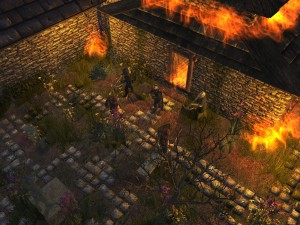 Nowadays, I can’t really complain about a lack of new RPGs coming out. Or even a lack of games made “the way they used to make them.” No, not with so many indie and “big indie” titles filling that “old-school RPG” niche. I used to sing the praises of the late 80s / early 90s with so many awesome (and… ahem, not-so-awesome) RPGs getting released each year. We dwarf that easily nowadays.
Nowadays, I can’t really complain about a lack of new RPGs coming out. Or even a lack of games made “the way they used to make them.” No, not with so many indie and “big indie” titles filling that “old-school RPG” niche. I used to sing the praises of the late 80s / early 90s with so many awesome (and… ahem, not-so-awesome) RPGs getting released each year. We dwarf that easily nowadays.
But as many predict with the “indiepocalypse”, these periods of glut lead to an inevitable collapse as supply greatly exceeds demand, and the makers can no longer afford to keep making their games. The end result is a shake-out, and only those with the (relatively) deep pockets can stay in business. But in the indie world, “Deep Pockets” means something pretty different from what it used to. A heavily committed hobbyist with a day-job to finance his game development activities (*cough* *cough*) can stick around through the lean times in a way that only the biggest publishers could back in the old day. They don’t need to depend on a well-heeled white knight to buy them up and save them. They don’t need to spend tons of money up-front or tons on marketing to stay relevant.
I think a fair-sized fraction of the games coming out right now are from just those kinds of developers. And then we have several successful studios that continue to be successful, if they can stay lean & mean. And of course, the big studios and publishers will keep doing their thing. So I don’t think the coming relative dearth of role-playing games is going to be all that noticeable. New developers will keep jumping into the fray. And role-playing games seem to be a pretty evergreen genre.
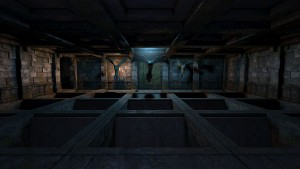 What I expect to see and hope to see will be more experimentation. I’m extremely happy that we’ve managed to go back and meet the pent-up need for the kind of “old-school” fun that was missing from the AAA releases a decade ago. My frustration back then wasn’t that we “evolved” so much as we picked one lowest-common-denominator branch and rode it all the way into the ground. Am I mixing metaphors enough? How about “milked it dry?” Anyway, since then we’ve gone back and rediscovered some classic ideas, systems, and styles. This is wonderful. I hope we never again forget our roots.
What I expect to see and hope to see will be more experimentation. I’m extremely happy that we’ve managed to go back and meet the pent-up need for the kind of “old-school” fun that was missing from the AAA releases a decade ago. My frustration back then wasn’t that we “evolved” so much as we picked one lowest-common-denominator branch and rode it all the way into the ground. Am I mixing metaphors enough? How about “milked it dry?” Anyway, since then we’ve gone back and rediscovered some classic ideas, systems, and styles. This is wonderful. I hope we never again forget our roots.
Purists may balk, but I think what needs to happen (and what is happening) is that we need to continue to innovate and explore from there. This isn’t going to always lead to success. That’s kind of the point of experimentation. The reason we got stuck in the rut we were in a decade ago. Sure, I hope we keep getting some games that stick with tradition and keep refining the experience with intriguing new stories and fascinating worlds and clever system variants. The existing frameworks are flexible enough to handle a lifetime of new, fresh-feeling content. But we also need to keep exploring the potential of what an RPG can be.
And as gamers, we need to keep an open mind, and be willing to take a chance on those games that might not strictly conform to our existing preferences or vision of what a CRPG should be. We’re RPG fans, so exploration should be second nature. Again, not every foray will be a successful one, and we may clear some titles off our pending list without ever getting close to completion. But as games are cheaper than ever nowadays, I don’t see that being a major setback, and there is treasure aplenty waiting to be found along less-traveled paths.
Filed Under: Biz, Indie Evangelism - Comments: Read the First Comment
Game Design: Puzzle-Solving vs. Problem-Solving
Posted by Rampant Coyote on December 28, 2015
 Many types of games emphasize puzzle-solving. Adventure games, hidden-object games, and many popular indie platformer games come to mind (Super Meat Boy being one of the best examples).
Many types of games emphasize puzzle-solving. Adventure games, hidden-object games, and many popular indie platformer games come to mind (Super Meat Boy being one of the best examples).
For me, puzzle-solving is overcoming a problem for which there is a narrow range (often only one) solution, or a “best” solution. The challenge may be in solving the puzzle, executing on the solution, or both. The emphasis here is on coming up with the “correct” solution (or one of a couple of variants).
Problem-solving is similar, but the core concept is fundamentally different. It’s way more loosy-goosey and open-ended. While there may be more optimal strategies than others, a problem-solving challenge is one in which there is not a well-defined solution.
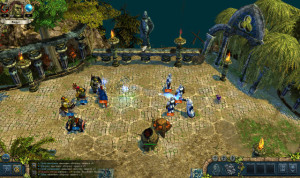 Most games incorporate some kind of problem-solving elements in them, but some genres make that more of a focus. Strategy / tactics games and role-playing games – particularly turn-based RPGs – come to mind. Boss battles in good action games tend to take this approach.
Most games incorporate some kind of problem-solving elements in them, but some genres make that more of a focus. Strategy / tactics games and role-playing games – particularly turn-based RPGs – come to mind. Boss battles in good action games tend to take this approach.
These are both great kinds of gameplay, but as a general rule, they don’t usually go well together. This isn’t to say you can’t mix the puzzle-solving into a problem-solving-focused genre or vice versa. It’s been done many times. In fact, you could come up with a very interesting game concept that way. Portal is an example – kind-of – turning what feels like a first-person shooter into a puzzle game. It can work if the entire game is designed around that focal change. Lightly mixing one element into the other may also work, but this has to be done with care. I remember some adventure games in the 1990s nearly ruined by the introduction of little action-sequences and whatnot. Many (most?) RPGs have some smaller, simpler puzzle elements that work well to add variety to the game, but enjoyment can be brought to a screeching halt by the introduction of a too-difficult mandatory puzzle sequence.
It’s like pizza and ice cream. I may enjoy them both a great deal separately, but I have less than zero interest in pizza-flavored ice cream.
It’s one of many problems with “kitchen sink” game design. The key is – as with everything in game design – understanding the “core” of the game and adding elements that accentuate that core rather than detracting from it.
Filed Under: Design - Comments: 4 Comments to Read
